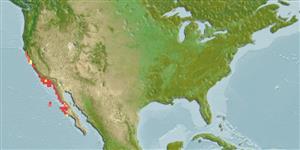Teleostei (teleosts) >
Ovalentaria/misc (Various families in series Ovalentaria) >
Embiotocidae (Surfperches)
Etymology: Embiotoca: Greek, embios = permanent, for all the life + Greek, tokos,-oy = birth (Ref. 45335); jacksoni: jacksoni for A.C. Jackson , who first noted that black perch bore living young and brought this information to the attention of Alexander Agassiz (Ref. 4930).
More on author: Agassiz.
Environment: milieu / climate zone / depth range / distribution range
Ecology
Marine; demersal; depth range 0 - 46 m (Ref. 2850), usually ? - 6 m (Ref. 2850). Subtropical; 40°N - 23°N, 124°W - 114°W
Eastern Pacific: Fort Bragg in northern California, USA to central Baja California in Mexico, including Guadalupe Island (off northern central Baja California).
Size / Weight / Age
Maturity: Lm ? range ? - ? cm
Max length : 39.0 cm TL male/unsexed; (Ref. 2850); max. published weight: 700.00 g (Ref. 2850); max. reported age: 10 years (Ref. 56049)
Adults chiefly live in rocky areas near kelp, occasionally over sand bottom of coastal bays and around piers and pilings, and rarely in surf. Occur from intertidal areas to 46 m depth, but usually at about 6.1 m. Usually form small groups. Viviparous, female carries the developing young (Ref. 205).
Life cycle and mating behavior
Maturity | Reproduction | Spawning | Eggs | Fecundity | Larvae
Viviparous, female carries the developing young (Ref. 205).
Eschmeyer, W.N., E.S. Herald and H. Hammann, 1983. A field guide to Pacific coast fishes of North America. Boston (MA, USA): Houghton Mifflin Company. xii+336 p. (Ref. 2850)
IUCN Red List Status (Ref. 130435)
Threat to humans
Harmless
Human uses
More information
ReferencesAquacultureAquaculture profileStrainsGeneticsElectrophoresesHeritabilityDiseasesProcessingNutrientsMass conversion
Tools
Can't connect to MySQL database fbquizv2. Errorcode: Too many connections
